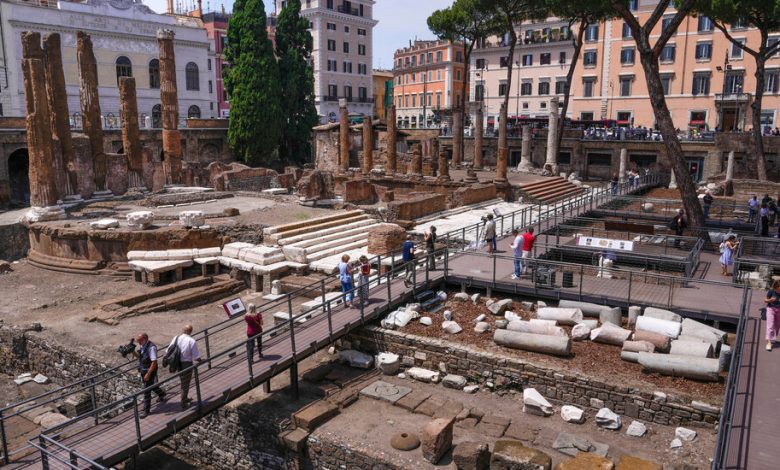Friends, Tourists, Countrymen, See Where Julius Caesar Was Killed

For nearly a century, only cats (and presumably the rats they kept at bay) had free rein over an ancient archaeological site in the heart of central Rome. They would prowl among the ruins and preen for the tourists who gathered along the balustrades above, cellphones and cameras in hand.
But as of Tuesday, human visitors were allowed for the first time to descend and get a better glimpse of the site, believed to be where Julius Caesar was brutally assassinated by a group of senators in 44 B.C. The spot is nestled in an area with four temples, rare remnants of the Roman Republic, dating from the fourth to the first centuries B.C.
The full site, called the Sacred Area of Largo di Torre Argentina, is the latest addition to Rome’s rich archaeological offerings. The Italian capital’s mayor, Roberto Gualtieri, said at the inauguration on Monday that the attraction would add “tremendous value to a city that never ceases to amaze with its treasures and wonders.” Rome was discovering “its history to the fullest,” he added.
There is no X-marks-the-spot where Julius Caesar met his bloody end on — as tradition and the Shakespeare play “Julius Caesar” would have it — the Ides of March, about the 15th day of the month. The spot contains just a jumble of limestone rocks, bricks and tufts of grass.
That might surprise some, said the archaeologist Monica Ceci, who oversees the site.
Visitors “may have a hard time imagining this, because the Shakespearean drama induces you to think that the murder was in the forum,” she said.
Caesar was actually assassinated at the Curia of Pompey, a large rectangular meeting hall where the Senate of Rome met occasionally. The emperor Augustus later declared the hall a “locus sceleratus,” or “cursed place,” and it was walled up.
But Shakespeare “could get away with” a little artistic license, Ms. Ceci laughed.
On the opposite side of the site, marble decorations and sculptures, for decades stored unseen in Rome’s archaeological warehouses, have been displayed in a long hall under the modern-day street. “It’s one thing to keep them in order on shelves, quite another to tell the history of this site through these fragments,” Ms. Ceci said.
Irina Lumsden, a data engineer visiting Rome from Melbourne, Australia, said that the site was transporting. “It’s amazing, you get such a feeling of ancient time here,” she said “They’ve done a great job of conserving the site.”
The area was rediscovered during excavations from 1926 to 1929, when the square was being demolished to make way for new buildings. The four temples unearthed were initially labeled with the first four letters of the alphabet because archaeologists were unsure which temples they had uncovered. Now they have been tentatively identified, though there is still scholarly debate: the Temple of Juturna, after a goddess of fountains, wells and springs, dating from the mid-third century B.C.; the Temple of Fortuna Huiusce Diei, or Fortune of the Present Day, built in the second century B.C.; the Temple of Feronia, a goddess of fertility, built about the end of the fourth century B.C.; and the Temple of Lares Permarini, dedicated to the protectors of navigation, or according to others to the Nymphs, and constructed in the early second century B.C.
The Curia of Pompey was erected a little later, in the first century B.C.
After a fire devastated this part of Rome in A.D. 80, the emperor Domitian restored the temples and a travertine slab floor, still visible, was built on top of the surrounding rubble.
Over the centuries, the area underwent various further transformations, remaining buried until the excavations in the 1920s. City officials at the time immediately understood the value of the archaeological find, and the site was closed off, to be admired only from above.
Monica Baraschi, a volunteer with a cat sanctuary that abuts one corner of the ancient site, said that even the feline residents — there were 86, she said — would feel some benefits from the opening up of the spot and the arrival of visitors.
“They’ll get cuddled and caressed — the cats will be happy,” she said.
In the past, Ms. Ceci, the archaeologist, acknowledged, there had been friction between archaeologists and the sanctuary, but she said that the cats had been “good workmates” during the two years that the site was undergoing work to prepare for the opening.
Visitors on the first day also seemed glad to see a bit of ancient Rome up close. Simeon Peebler, a software engineer from Chicago, said, “In a world of virtual-reality experiences, to have a real reality experience is amazing.”
Romans were equally delighted. Sandro Lubattelli, a retired computer engineer and his wife, Rossana Cipressi, a retired teacher, said that they had spent a lifetime looking at the site from above and were thrilled to finally be able to go in.
“We always wondered why it was closed,” Mr. Lubattelli said. “We’re in seventh heaven.”




